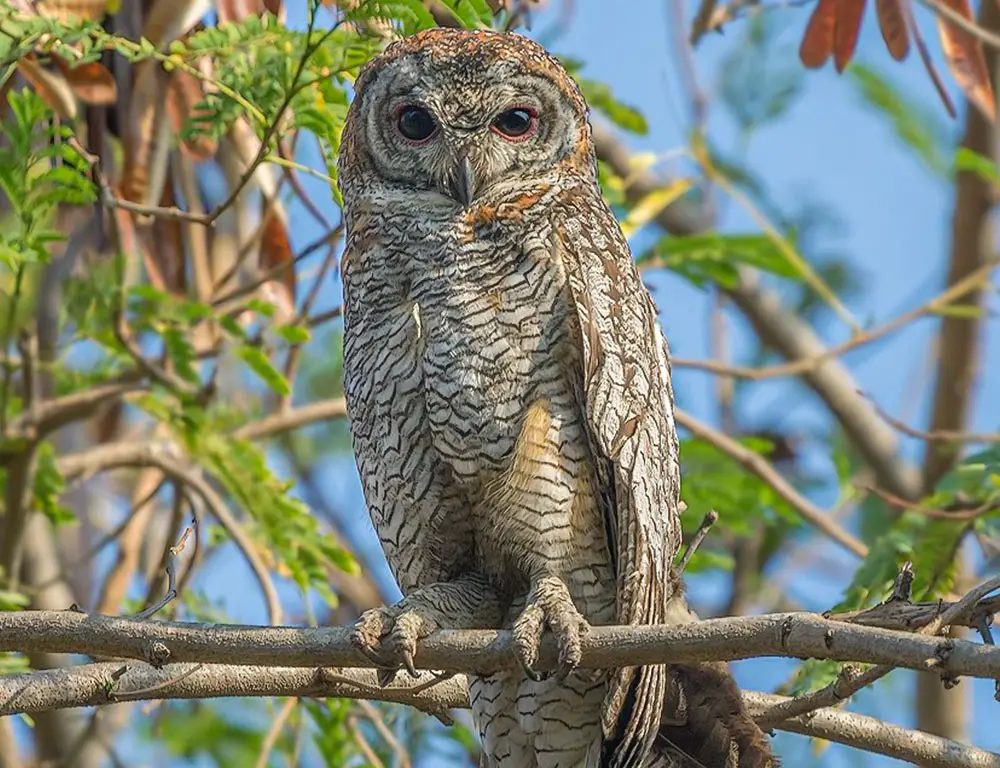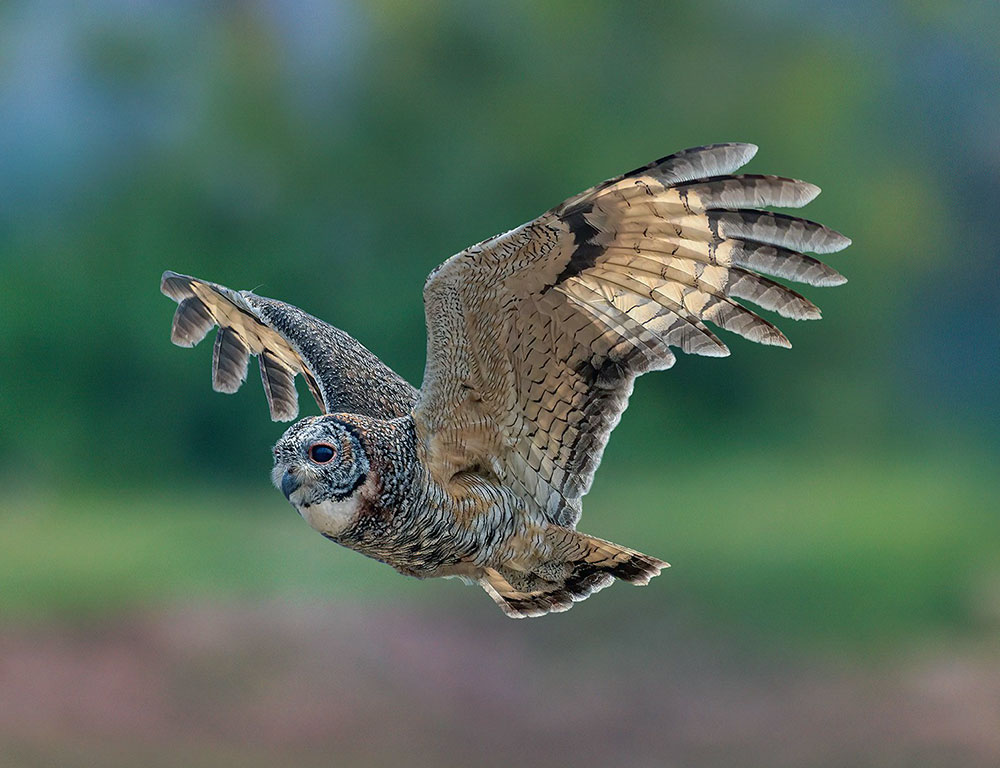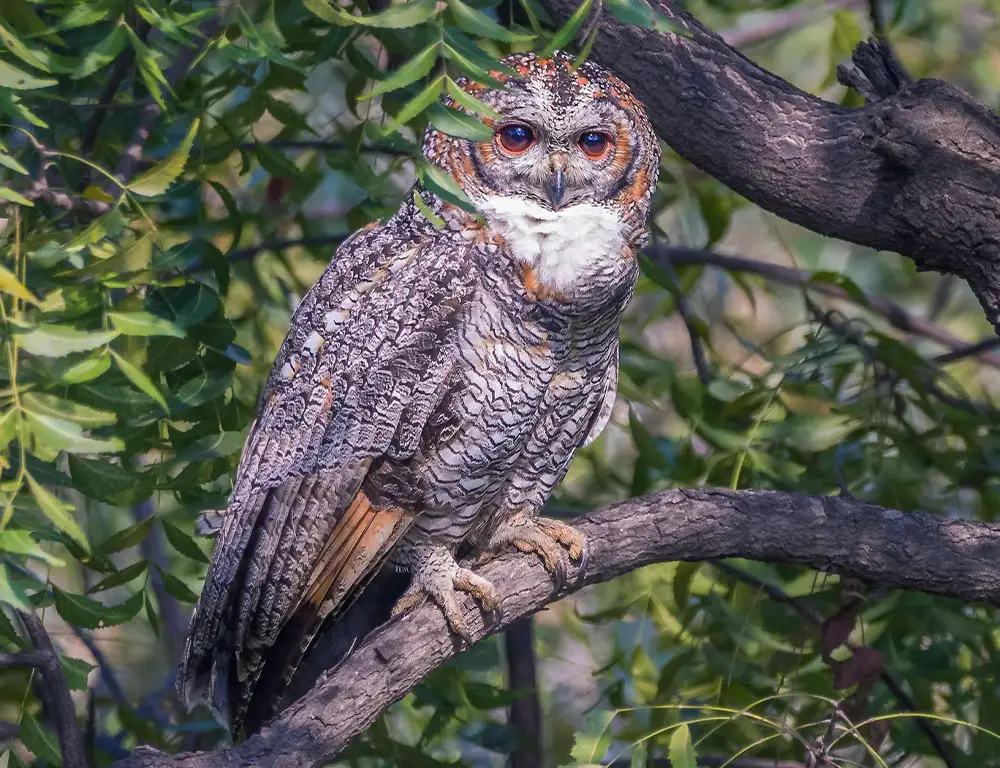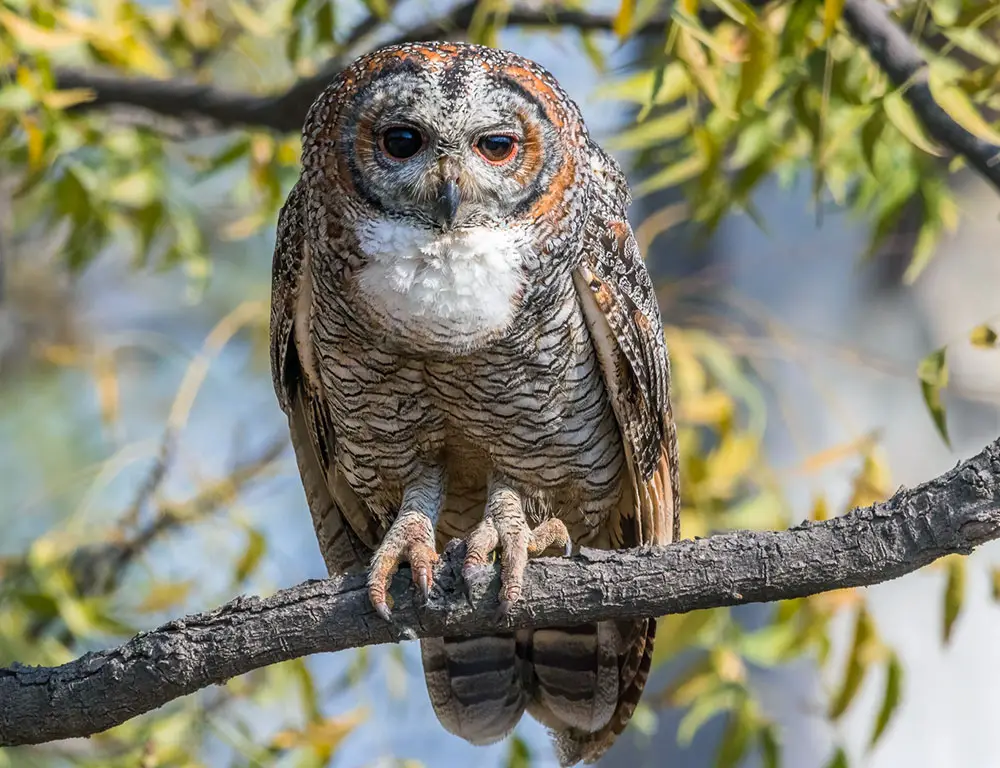If you’ve ever wandered through the forests of India after sunset, you may have heard a peculiar hooting sound echoing through the trees. That haunting call is none other than the Mottled Wood Owl, an intriguing creature that’s captivated my interest for years.
They’re nocturnal birds known for their distinct vocalizations and unique appearance.
The Mottled Wood Owl isn’t your typical woodland bird. Sporting a large size, with males reaching up to 46 cm in length, it’s certainly not easy to miss if you’re lucky enough to spot one.
The owl’s mottled brown and white plumage helps it blend seamlessly into its forest surroundings—nature’s camouflage at its finest.
However, its fascinating behavior and lifestyle truly set this species apart. Unlike many of their kin who prefer solitude, Mottled Wood Owls are often found in pairs or small family groups.
Seeing these owls interact within their tight-knit community is always an extraordinary sight!
Physical Characteristics of the Mottled Wood Owl

The Mottled Wood Owl (Strix ocellata) possesses a captivating array of physical characteristics that make it a genuinely mesmerizing creature.
Size
Falling within the medium-sized owl category, Mottled Wood Owls typically range from 42 to 57 cm (16.5 to 22.4 inches), with an impressive wingspan extending from 80 to 95 cm (31.5 to 37.4 inches).
Head
They have a distinctive rounded head and lack the ear tufts seen in some other owl species.
Plumage
The hallmark of their appearance is their mottled plumage, which consists of an intricate pattern of white and brown feathers across their body.
This mottling provides exceptional camouflage within their woodland habitats, with more pronounced mottling on their backs and streaking on their underparts.
Eyes
Mottled Wood Owls possess huge, deep, dark brown eyes against a facial disc that’s pale grey-brown rimmed with black-brown bristles. This contrast creates an intense gaze that can be both captivating and eerie.
Weight
There’s a noticeable weight difference between males and females, with females typically being heavier. Female Mottled Wood Owls weigh around 750 grams (26 ounces), while males weigh approximately 500 grams (18 ounces).
Talons
Like most owls, they have potent talons designed for hunting small mammals and birds in woodland habitats. Their feet are fully feathered, extending up to their deadly curved claws, which adds another layer of intrigue to these fascinating birds.
Habitat and Distribution of the Mottled Wood Owl

The Mottled Wood Owl (Strix ocellata) is a versatile species, adapting to various habitats across the diverse landscape of India.
Here’s a closer look at its preferred habitats and distribution:
Rajasthan
Within Rajasthan, Mottled Wood Owls are commonly found inhabiting scrub forests and areas with thorny vegetation. These semi-desert environments provide suitable conditions for their survival.
Gujarat
In Gujarat, these owls make their homes in mango plantations or deciduous forests. They exhibit adaptability to both agricultural landscapes and natural forested areas.
Karnataka
In the southern state of Karnataka, Mottled Wood Owls are often spotted amidst teak plantations and bamboo clumps. These habitats offer ample tree cover and diverse vegetation for roosting and hunting.
Maharashtra & Madhya Pradesh
Dry deciduous forests in Maharashtra and Madhya Pradesh are perfect habitats for these owls. The mix of trees and open spaces provides suitable hunting grounds.
A quick peek at their distribution across India would look something like this:
| State | Preferred Habitat |
| Rajasthan | Scrub Forests, Thorny Vegetation |
| Gujarat | Mango Plantations, Deciduous Forests |
| Karnataka | Teak Plantations, Bamboo Clumps |
| Maharashtra & Madhya Pradesh | Dry Deciduous Forests |
Behavior and Diet of the Mottled Wood Owl

The Mottled Wood Owl (Strix ocellata) exhibits fascinating behavior and dietary habits, making it a captivating species to observe in the nocturnal realm of South Asian forests.
Behavior
- Nocturnal Lifestyle: Mottled Wood Owls are primarily active at night, contrasting with diurnal bird species commonly seen during the daytime.
- Solitary or Paired: They prefer solitude or pairs over large groups, maintaining fiercely defended territories.
- Territorial Behavior: These owls establish and defend territories, exhibiting territorial behavior to safeguard their hunting grounds.
- Hunting Strategy: They primarily employ a ‘sit-and-wait’ strategy while hunting, perching silently on a branch until unsuspecting prey passes by, then swooping down for the kill.
- Vocalizations: Their calls consist of a series of hoots that increase in tempo then gradually slow down. These vocalizations are used for communication between individuals, especially during the mating season.
Diet
- Varied Diet: Mottled Wood Owls are not picky eaters, consuming a diverse range of prey.
- Small Mammals: Rats and mice form a significant portion of their diet.
- Birds: They also prey on smaller bird species.
- Insects: Various insects contribute to their feeding routine.
Conservation Status of the Mottled Wood Owl

The conservation status of the Mottled Wood Owl (Strix ocellata) reveals a concerning decline in population numbers despite its current classification as “Least Concern” on the IUCN Red List.
Here’s a closer look at the situation:
Threats
One of the primary threats Mottled Wood Owls face is habitat loss due to rampant deforestation and agricultural expansion. Their habitats are shrinking alarmingly, leaving them with fewer resources for nesting, roosting, and hunting.
Conservation Efforts
- Legal Protection: Mottled Wood Owls are legally protected under wildlife laws in many regions. However, enforcement of these laws is often inadequate, leading to continued habitat destruction.
- Habitat Preservation: Initiatives aimed at preserving and restoring owl habitats are underway, but more concerted efforts are needed to address the scale of habitat loss.
Sustainable Practices
Sustainable forestry practices, including limiting deforestation and promoting reforestation projects, are essential for mitigating habitat loss and ensuring the long-term survival of Mottled Wood Owls.
Public Awareness
It is crucial to raise public awareness about the importance of conserving Mottled Wood Owls and their role in maintaining ecological balance. Many people are unaware of these owls’ threats and the need for conservation action.
Here are some stats to put things into perspective:
| Year | Estimated Population |
| 2010 | 10,000 – 100,000 |
| 2020 | 10,000 – 20,000 |
Conclusion
I’ve spent my time diving deep into the world of the Mottled Wood Owl and I must say, it’s been a fascinating journey. These creatures are as intriguing as they are elusive, making them an interesting subject for any wildlife enthusiast.
One can’t fail to be impressed by their unique adaptations for survival. The mottled pattern on their feathers is more than just appealing aesthetics – it’s a clever camouflage technique that keeps them safe from predators during their nocturnal adventures.
We’ve learned some additional facts:
- Mottled Wood Owls have keen eyesight and hearing, enabling them to locate prey even in pitch darkness.
- They’re found mainly in India – particularly in the deciduous forests of the Western Ghats.
- Their diet primarily consists of rodents, small mammals, and birds.
| Fact | Description |
|---|---|
| Eyesight & Hearing | Exceptional |
| Habitat | Deciduous forests of Western Ghats (India) |
| Diet | Rodents, small mammals, birds |
But what struck me most about these owls is their complex social structure. They’re known to form long-term pair bonds and engage in intricate courtship behaviors – something that’s been less studied but equally captivating.
In closing this exploration into the life of the Mottled Wood Owl, I’m reminded again why studying nature never ceases to amaze me. There’s always something new just waiting to surprise you!
And while we may feel like we know all there is about this intriguing species now – let me assure you, there’s still so much left untold. After all, isn’t that the beauty of nature? It constantly keeps us on our toes!